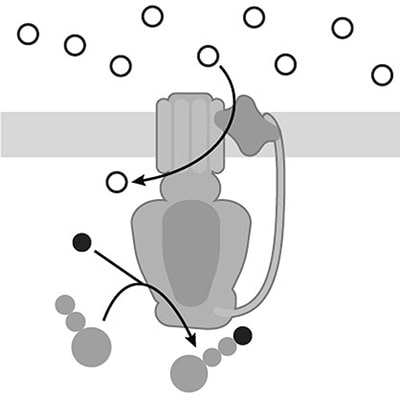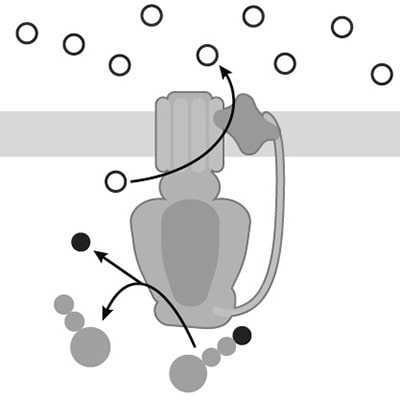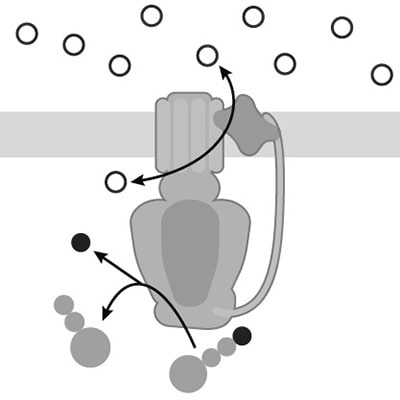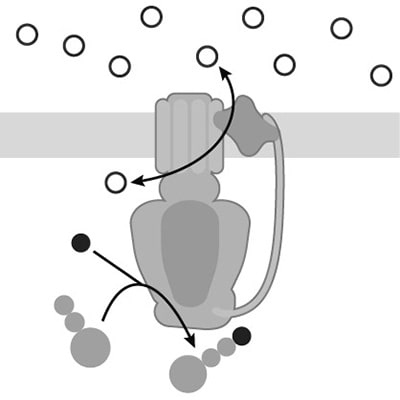The AP Biology multiple-choice questions (MCQs) section assesses your understanding of core biological concepts. It consists of 60 AP Bio MCQs, accounting for 50% of your total score. We'll show you winning strategies for tackling different question formats and provide AP Biology sample multiple-choice questions to test your knowledge.
Types of AP Biology Multiple-Choice Questions
Let's explore the different AP Bio MCQ types you'll encounter on the AP Biology exam so you can develop effective strategies for each.
Text-Based Questions
These questions test your ability to analyze information presented in a passage. Short-form text questions generally test your knowledge-based skills, while long-form text questions give some background information that you will have to combine with your existing knowledge. Don't underestimate either format – approach both with equal focus!
Tips for answering text-based questions:
- Read and highlight key information in the question.
- Recall prior knowledge on the topic.
- Eliminate obviously wrong answers.
- Choose the best answer.
- Mark any answers you’re unsure of to revisit later if there’s time.
For more detailed preparation, consider exploring the AP Biology Prep Course to master these question types with guided instruction.
Short-Form Text
This type of question is generally 1 to 3 sentences. Here’s an example:
The combined expression of several genes has been shown to influence the production of unique fingerprint patterns in each human being. These fingerprint patterns are fully formed approximately two months before birth. Which of the following would confirm that fingerprint pattern is an example of a trait exhibiting phenotypic plasticity?
- A) Fingerprint patterns always differ when comparing two individuals that are not related.
- B) Identical twins sharing all their DNA sequences still express different fingerprint patterns.
- C) If the genes responsible for coding fingerprint patterns are inhibited, fingerprint patterns will not form before birth.
- D) Each gene that codes for fingerprint patterns is transcribed at a different time point during embryonic development.
To answer this question, you will need to know the definition of phenotypic plasticity, a term that will be tested on the exam, and apply it to the given question scenario.
Long-Form Text
Summarize the passage itself: Jot down key points to help you analyze the information quickly. Here’s an example:
Many species of ants live together in large groups, called colonies, which contain fertile males and either fertile or sterile females. The fertile females, called queens, lay eggs and mate with males. The queen stores male sperm in an internal pouch and selectively uses the sperm to determine the sex of her offspring.
Eggs are fertilized when the queen allows for the deposition of the male’s sperm into her reproductive tract. If
there is no deposition of sperm, her eggs remain unfertilized. Unfertilized eggs develop as fertile males
whereas fertilized eggs develop as either fertile or sterile females. The queen produces mainly sterile female
offspring that work for the colony but when some fertilized eggs are given proper nourishment, fertile queen
offspring are produced.
Which of the following best explains why evolution has led to the continued presence of
sterile females in these various ant species?
- A) Sterile and fertile ants within the same colony exhibit different phenotypes, causing increased genetic diversity of the colony.
- B) The large number of sterile females drastically increases competition for resources among ants within the colony, allowing only some individuals to survive.
- C) Sterile females devote most of their energy to feeding and protecting fertile individuals and their offspring, increasing the chances that genes within the colony are passed to future generations.
- D) The genes of sterile females are unaffected by natural selection, causing their genetic material to never be passed to the next generation.
What You Must Know:
This question is a lot to read through, but the key terms you need to know are evolution and natural selection.
You can apply your knowledge of these terms to the information presented in the question stem to arrive at the
correct answer choice.
Diagram-Based Questions
Analyze the diagram and text either above or below it.
Tips for answering diagram-based questions:
- Read and highlight key information in the question.
- Examine the diagram and mark relevant parts.
- Eliminate obviously wrong answers.
- Choose the best answer.
- Mark any answers you’re unsure of to revisit later if there’s time.
To get a comprehensive overview of these question types and enhance your practice, check out the AP Biology Practice Test Questions, which provide a wide range of real exam-like questions to test your skills.
Here’s an example:
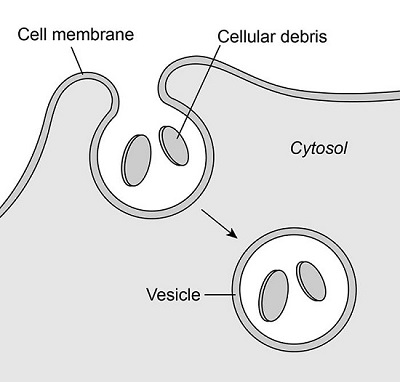
The diagram above depicts endocytosis of cellular debris by a cell. The arrow indicates the movement of the vesicle that was derived from the plasma membrane during this process. If the engulfed cellular debris is to be digested to allow the materials to be recycled by the cell, which of the following will most likely occur following endocytosis?
- A) The vesicle will expel the debris via exocytosis.
- B) The vesicle will move to the Golgi apparatus.
- C) The vesicle will fuse with a lysosome.
- D) The vesicle will synthesize hydrolytic enzymes.
What You Must Know:
To tackle this question, you need to understand the process of endocytosis and the function of different cellular organelles. You will then apply your knowledge of these concepts to the diagram in the question stem to choose the best answer.
Data Table-Based Questions
These questions test your ability to analyze data tables with surrounding text. Use the data and any other information provided to answer. Sometimes, you may also need to recall content knowledge to answer this type of question.
Tips for answering data table-based questions:
- Read and highlight key information in the question.
- Examine the table, focusing on headings and title (if present).
- Identify relevant data patterns.
- Eliminate obviously wrong answers.
- Choose the best answer.
- Mark any answers you’re unsure of to revisit later if there’s time.
Here is an example:
| Cell | Deficient in |
|---|---|
| 1 | Simple carbohydrates |
| 2 | rRNA |
| 3 | Nucleotides |
| 4 | Amino acids |
In an experiment, four cells are being assessed for the efficiency at which they perform transcription. These four cells have each been experimentally manipulated to be deficient in one specific molecule. However, all cells still contain enough molecules to function at levels necessary for survival. The table above lists the cells and their molecular deficiencies. Assuming all other conditions in the cells are equal, which experimental cell is predicted to be the LEAST efficient at performing transcription?
- A) Cell 1
- B) Cell 2
- C) Cell 3
- D) Cell 4
What You Must Know:
To approach this question, you need to have a basic understanding of the transcription process and the molecules involved. Using this knowledge, you will be able to select the correct answer choice from the options presented in the table.
Graph-Based Questions
Analyze data trends using your graphing knowledge. Graphs present data with labels, legends, and captions.
Tips for answering graph-based questions:
- Read and highlight key information in the question.
- Examine the graph (axes, legend, caption).
- Mark relevant data points.
- Eliminate obviously wrong answers.
- Choose the best answer.
- Mark any answers you’re unsure of to revisit later if there’s time.
Practicing with AP Biology practice MCQs will help you become comfortable interpreting different types of graphs, ensuring you're well-prepared for the exam.
Here’s an example:
MCQ 5 Example
Scientists are studying cell division in two different eukaryotic cell types.
For each cell type, they record the number of chromosomes present in the parental cell prior to cell division,
and then record the number of chromosomes present in one of the daughter cells after the completion of cell
division. The results of this study are shown in the graph below.
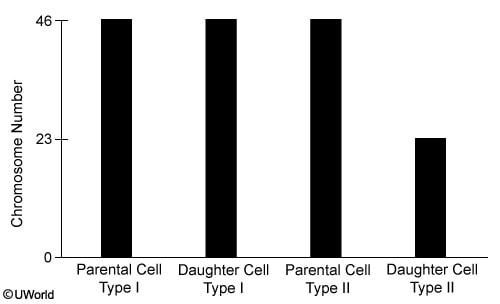
Which of the following processes most likely occurs during cell division in cell type II but not in cell type I?
- A) Condensation of chromatin
- B) Pairing of homologous chromosomes
- C) Production of genetically identical daughter cells
- D) Distribution of cellular organelles to daughter cells
What You Must Know:
This question relies on your understanding of mitosis and meiosis, along with key similarities and differences
between the two processes. Using the graph in the stem, you will apply your understanding to select the best
choice.
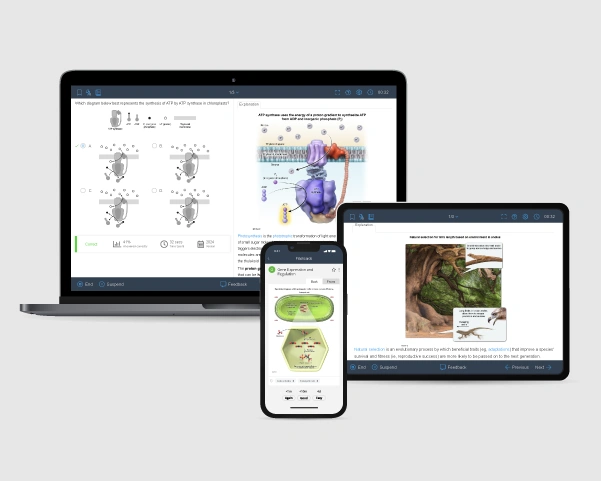
Calculations-Required Questions
These questions require calculations using information from the question stem, text, tables, or graphs. Refer to the provided Equations and Formulas sheet and approved calculator for assistance.
Tips for answering calculations-required questions:
- Read the question carefully and highlight key information.
- Use scratch space provided to avoid answer sheet marks.
- Eliminate obviously wrong answers.
- Choose the best answer.
- Mark any answers you’re unsure of to revisit later if there’s time.
Here is an example:
MCQ 6 Example
The polymerase chain reaction (PCR) is an experimental technique in which DNA
segments are amplified. Each round of PCR causes the amount of DNA present to double. Assuming the rate of
amplification remains consistent, how many copies of one double-stranded DNA segment will be present after five
rounds of PCR?
- A) 8
- B) 16
- C) 32
- D) 256
What You Must Know:
In addition to basic math skills, you must also understand the
polymerase chain reaction to perform the calculations required to answer this question.
Image Answer-Choice Questions
These questions challenge you to choose the image (graph, diagram, etc.) that best represents the answer, not a written answer choice. The question stem may include an image itself.
Graph Answer-Choice Questions
These questions will require you to select the answer choice with the best graphical representation of the question.
Tips for answering image answer-choice questions:
- Read and highlight key information in the question,
- Analyze each image: Focus on labels, units (axes), and legends. Mark relevant parts.
- Eliminate obviously wrong answers.
- Choose the best answer.
- Mark any answers you’re unsure of to revisit later if there’s time.
Here’s an example:
Differentiation is the process by which less complex, immature cells develop into their mature, complex forms. Fibroblasts are a type of cell specialized for synthesizing and secreting fibers of the protein collagen. Nerve cells are characterized by their ability to be excited, that is, to change their membrane potential in response to stimuli. In their differentiated states, fibroblasts and nerve cells have different patterns of gene expression.
In a research study, a team of investigators introduced the genes for three nerve cell–specific transcription factors into fibroblasts. They hypothesized that changing the pattern of gene expression in fibroblasts by this means would cause them to develop characteristics of nerve cells. To assess this possibility, they measured the membrane potential and capacitance (charge separation across the membrane) 8 days and 20 days after the expression of nerve-specific transcription factors was initiated in fibroblasts. The results were compared with values from a control set of nerve cells. Which of the following best predicts the results if the investigators’ hypothesis is correct?
- A)
- B)
- C)
- D)
This question has a long stem and requires you to choose a graphical representation as the correct answer. Apply your knowledge of cell differentiation and transcription factors to choose the best answer.
Diagram Answer Choice Questions
These questions will require you to select the choice with the best diagrammatic representation of the answer.
Tips for answering diagram answer-choice questions:
- Read and highlight key information in the question.
- Examine each diagram and mark relevant parts.
- Eliminate obviously wrong answers.
- Choose the best answer.
- Mark any answers you’re unsure of to revisit later if there’s time.
Here is an example:
MCQ 8 Example
Which diagram below best represents the synthesis of ATP by ATP synthase in
chloroplasts?

- A)
- B)
- C)
- D)
What You Must Know:
This question relies on your knowledge of ATP synthesis and how it is involved in this process in chloroplasts.
Choose the best image representing ATP synthesis from the options provided.
Passage-Based Questions
These questions test your understanding of a passage reading on the exam. Passages can be short or long, with text only or figures such as graphs and diagrams. Each passage comes with 4-5 related questions.
Tips for answering passage-based questions:
- Skim the passage and figures quickly. Don't get bogged down in details.
- Read questions carefully and highlight key information. Note references to figures in the question (e.g., "Based on Figure 2").
- Focus on relevant passage sections based on the questions.
- Eliminate obviously wrong answers.
- Choose the best answer.
- Mark any answers you’re unsure of to revisit later if there’s time
See an example of this type of question below.
Passage
First, read the passage and take a shot at answering the associated question
below.
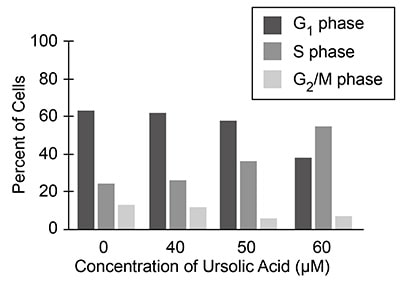
Figure 1. Percent of cells in different phases of the cell cycle in relation to ursolic acid concentration
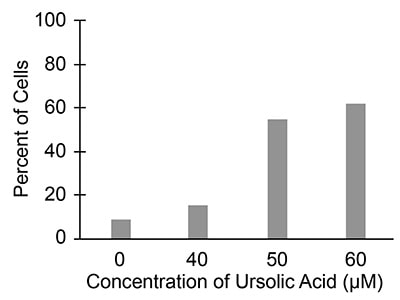
Figure 2. Percent of cells undergoing apoptosis in relation to ursolic acid concentration
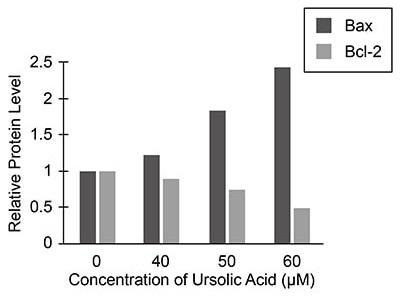
Figure 3. Expression of Bax and Bcl-2 proteins in relation to ursolic acid concentration.
Ursolic acid is a compound known to affect human cells, but its mechanism of action is uncertain. In an experiment, human gallbladder cancer cells growing in culture were exposed to different concentrations of ursolic acid. After 48 hours, the percent of cells in the different phases of the cell cycle was determined. The data are shown in Figure 1. Scientists also determined the percent of cells undergoing apoptosis (Figure 2) as well as the expression of two intracellular proteins, Bax and Bcl-2 (Figure 3).
A scientist hypothesizes that ursolic acid could be used as a drug to slow the growth of some kinds of cancerous tumors. Based on the data in Figure 2, which of the following best evaluates the scientist’s hypothesis?
- A) The hypothesis is not supported because the percent of cells undergoing apoptosis decreased with increasing ursolic acid concentration.
- B) The hypothesis is not supported because a large percentage of gallbladder cancer cells did not undergo apoptosis when exposed to ursolic acid.
- C) The hypothesis is supported because a small percentage of gallbladder cancer cells underwent apoptosis without being exposed to ursolic acid.
- D) The hypothesis is supported because the percent of cells undergoing apoptosis increased with increasing ursolic acid concentration.
What You Must Know:
This question requires knowledge of hypotheses and the experimental
method. You will use this knowledge to analyze data in a passage figure and choose the best evaluation of the
hypothesis.
Understanding the different multiple-choice question types on the AP Biology exam is a powerful step towards success. Now that you're familiar with these formats, you can focus on developing strong test-taking skills and mastering the core biological concepts.
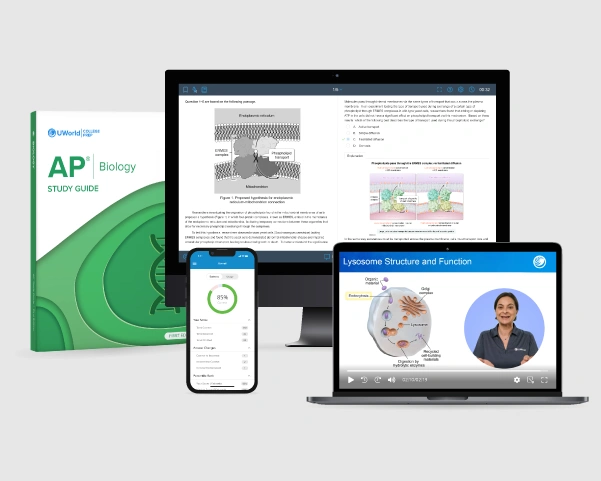
Frequently Asked Questions (FAQs)
How many multiple-choice questions are on the AP Bio Exam?
How are AP Bio multiple-choice questions graded?
How long is the multiple choice questions section of the AP Biology Exam?
When/where can I get the AP Biology past exam multiple choice questions?
Since 2012, College Board® has not released official past AP Biology MCQs. However, you can use alternative prep resources such as textbooks, online materials, and practice questions from UWorld’s AP Biology Study Guide, available in digital and print formats.
References
- (2024). Exam Format. AP Biology. AP Central Retrieved January 06, 2025 from
https://apcentral.collegeboard.org/courses/ap-biology/exam
Related Topics
Master AP Biology Free-Response Questions with UWorld. Access sample FRQs, study tips, and strategies to excel in this important section of the AP Biology Exam!
How to Study for AP BiologyExplore UWorld’s AP Bio study guide with expert strategies and key concepts to excel in the exam. Prepare effectively with comprehensive study methods and tips.
AP Biology Course and Exam Description (CED)Check out our guide to the AP Biology curriculum for detailed information on units, topics and key concepts you will study in the course to prepare effectively.
Best AP Biology Prep Course ReviewSearching for top AP Biology prep courses? Read this review to compare the best courses and choose the perfect one for your success.
Best AP Biology Study Guide ComparisonCompare the best AP Biology study guides! See how Kaplan, Barron's, and Princeton Review stack up against UWorld for comprehensive exam prep.
How to Self-Study for AP BiologyLearn effective tips and strategies to self-study for the AP Biology exam. Build confidence, master core concepts, and achieve a high score independently, too.







